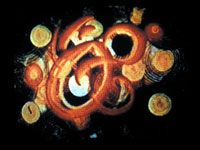This will be an intro to using After Effects
Secondary Motion - After you have made your different items bounce, what things can you add to sell their materiality?
Secondary Motion - After you have made your different items bounce, what things can you add to sell their materiality?
Basic kinesthetics
Stylized Worlds (aka Cartoon Physics)
EXAMPLES:
Demo: After Effects to Photoshop and back again.
Resources:
Create a 20 second frame by frame animation at a rate of 12 frames per second. The resolution should be 720 x 480. (Those using stop motion software, do select a resolution closest to this).
Grading criteria:
At least one of the following attributes should follow a narrative arc. A satisfactory resolution of multiple attribute arcs will result in a higher grade.
* rhythm
* pace
* flocking
* color
* line shape
* spatial relationship
This is certainly ambiguous and very open ended. Class examples and discussion will provide context. (Another way of saying, do not miss these first few classes).
Ending in death, while acceptable, is discouraged. (It's just too easy).
If using Flash - NO MOTION TWEEN OR CLASSIC TWEEN!!
iStopmotion is grand for the mac.
For PC users, check out
http://stopmotionworks.com/stopmosoftwr.htm
And of course, sourceforge,net
AnimatorDV looks promising. We'll wait for our itinerant reviewers to weigh in.
Sound adds very much to the atmosphere and general tone of the animation.
Examples:
DEMO Adobe Premiere and its sound editing ability
NOTES:
Before you load the images into photoshop, make a blank video layer and then change the document settings to the appropriate length and frames per second...THEN import your images as a video layer from a file.
What happens if you change it after the fact, it drops the frames in-between.
Links to help with Premiere:
DEMO of iStopMotion
Note: Here's a tutorial on using Photoshop to import images for stop motion
There are myriad ways to attack the problem. Essentially all we need is a way to string a series of individually drawn images together. We could use Flash, Fireworks, Imageready, and others. Over these 10 weeks we will attack the animation problem a variety of ways.
Today we will use Photoshop (and maybe some Flash).
Helpful links: www.adobe.com/go/vid0027 for an introduction to the video layer.
The Exercise:
Using either flash or photoshop create the following frame by frame animation.
Exercise 1
1.a. Some thing traverses from left to right
1.b. Some thing else traverses with a different kind of locomotion and interacts with it.
Exercise 2
2.a. Rotate a head (species of your choice)
2.b. The head does at least one expression
2.c. Rotation continues

Beyond Mickey
Georges Melies - A trip to the moon (1902) - 6 from sinematek on Vimeo.
Georges Melies - A trip to the moon (1902) -3 from sinematek on Vimeo.
Georges Melies - A trip to the moon (1902) -2 from sinematek on Vimeo.
Georges Melies - A trip to the moon (1902) -1 from sinematek on Vimeo.
Why do we see animation the way we do? How do we make it? What are the different kinds?
And so we begin...
This class blog is designed to serve as your interactive syllabus, class outline, and project timekeeper. This will be where I post readings, assignments, and information about the class.
A quick intro to its use:
Use the tabs at the top to navigate to specific sections (like the syllabus and the course outline), and the calendar on the left to find materials related to a specific class meeting.
Please review the IT department and RIT policies academic dishonesty.
| Assignment | % value | due date | rubric |
|---|---|---|---|
| experimental animation | 20% | Week 3: 3/24 | *** |
| rotoscope | 20% | Week 5: 4/07 | *** |
| walk cycle | 20% | Week 7: 4/21 | *** |
| exquisite corpse | 10% | Week 9: 5/05 | *** |
| final project | 30% | scheduled exam time | *** |
2nd year standing in the BS in Game Design and Development or New Media
Upon completion of the course, students will have a working definition of animation systems and techniques for digital media. Students will be able to create rudimentary animation cycles with an understanding of effective visual communication of physical attributes of inertia, momentum and transformation. Emphasis will be upon rendering movement.
This course provides a theoretical framework covering principles of animation and its use in gaming to affect user experience. Emphasis will be upon principles that support character development and animation that show cause and effect. Students will apply these principles to create animations that reflect movement and character appropriate for different uses and environments.
Last day of add/drop is March 14, 2010.
Last day to withdraw with a grade of "W" is April 30 (the deadline for withdrawing from a course with a W grade is the end of the 6th week of the quarter). Forms may be obtained from your department office and need your instructor's signature.
NOTE: Department policy states that a student has one quarter to challenge any grade. After that, grades cannot be challenged.
The following things are required for the course.
Professor: Kim Heintz
Office: 70-2675
Email: knhics at rit dot edu
Office Hours: Tues 6-8pm and by appt.